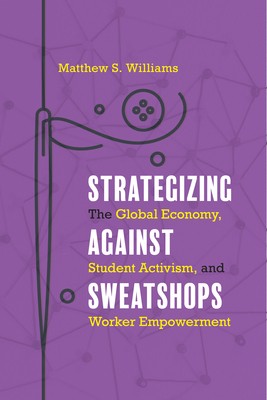
- We will send in 10–14 business days.
- Author: Matthew S Williams
- Publisher: Temple University Press
- ISBN-10: 1439918228
- ISBN-13: 9781439918227
- Format: 15.2 x 22.9 x 2 cm, softcover
- Language: English
- SAVE -10% with code: EXTRA
Reviews
Description
For the past few decades, the U.S. anti-sweatshop movement was bolstered by actions from American college students. United Students Against Sweatshops (USAS) effectively advanced the cause of workers' rights in sweatshops around the world. Strategizing against Sweatshops chronicles the evolution of student activism and presents an innovative model of how college campuses are a critical site for the advancement of global social justice.
Matthew Williams shows how USAS targeted apparel companies outsourcing production to sweatshop factories with weak or non-existent unions. USAS did so by developing a campaign that would support workers organizing by leveraging their college's partnerships with global apparel firms like Nike and Adidas to abide by pro-labor codes of conduct.
Strategizing against Sweatshops exemplifies how organizations and actors cooperate across a movement to formulate a coherent strategy responsive to the conditions in their social environment. Williams also provides a model of political opportunity structure to show how social context shapes the chances of a movement's success--and how movements can change that political opportunity structure in turn. Ultimately, he shows why progressive student activism remains important.
EXTRA 10 % discount with code: EXTRA
The promotion ends in 20d.17:59:06
The discount code is valid when purchasing from 10 €. Discounts do not stack.
- Author: Matthew S Williams
- Publisher: Temple University Press
- ISBN-10: 1439918228
- ISBN-13: 9781439918227
- Format: 15.2 x 22.9 x 2 cm, softcover
- Language: English English
For the past few decades, the U.S. anti-sweatshop movement was bolstered by actions from American college students. United Students Against Sweatshops (USAS) effectively advanced the cause of workers' rights in sweatshops around the world. Strategizing against Sweatshops chronicles the evolution of student activism and presents an innovative model of how college campuses are a critical site for the advancement of global social justice.
Matthew Williams shows how USAS targeted apparel companies outsourcing production to sweatshop factories with weak or non-existent unions. USAS did so by developing a campaign that would support workers organizing by leveraging their college's partnerships with global apparel firms like Nike and Adidas to abide by pro-labor codes of conduct.
Strategizing against Sweatshops exemplifies how organizations and actors cooperate across a movement to formulate a coherent strategy responsive to the conditions in their social environment. Williams also provides a model of political opportunity structure to show how social context shapes the chances of a movement's success--and how movements can change that political opportunity structure in turn. Ultimately, he shows why progressive student activism remains important.


Reviews